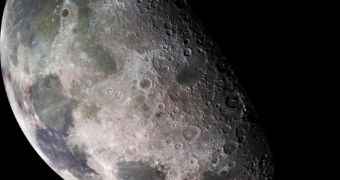Officials at NASA announce that all the scientific instruments aboard the Lunar Atmosphere and Dust Environment Explorer (LADEE) spacecraft have been successfully tested and commissioned, and say that the orbiter has begun collecting data on the surface of Earth's natural satellite.
Since achieving orbital insertion around the Moon, on October 6, 2013, the spacecraft has carried out a series of four Orbit Lowering Maneuvers (OLM), the last of which occurred on November 20. Following this step, the orbiter is now in its designated science operations orbit.
Its trajectory takes it through a periapsis altitude of between 20 and 50 kilometers (12.5 to 31 miles), and an apoapsis altitude of 75 to 150 kilometers (46.5 to 93.2 miles). The spacecraft's original orbit was located 250 kilometers (155 miles) above the surface of the Moon.
LADEE was launched into space by a Minotaur V delivery system, which took off from the Mid-Atlantic Regional Spaceport (MARS) on September 7, 2013. MARS is located at the NASA Wallops Flight Facility, on Wallops Island, Virginia.
The mission has three main goals, including the detection of properties related to the lunar exosphere (such as composition, variability and density). Additionally, the prove will also attempt to figure out whether diffuse emissions seen high above the surface by Apollo astronauts were radiations or dust.
Thus far, the LADEE Neutral Mass Spectrometer (NMS) was able to detect traces of atmospheric helium high above the lunar surface, while the Lunar Dust EXperiment (LDEX) started conducting meaningful science experiments as soon as its protective cover was removed.
The orbiter is scheduled to spend 100 days around the Moon. “The team was able to conduct preliminary science activities when LADEE’s orbit brought it closest to the surface of the moon and across the sunrise terminator – the transition from night to day,” mission controllers said in a recent statement.
The 383-kilogram (844-pound) satellite is scheduled to conduct scientific investigations for at least 3 months, though its mission may be extended further. In terms of payloads, it carries the NMS, which is similar to an instrument on the Mars Science Laboratory (MSL) rover Curiosity.
The UV-Vis Spectrometer (UVS) will conduct exosphere and dust studies, and resembles an instrument on the NASA Lunar Crater Observation and Sensing Satellite mission. Other instruments include LDEX, and a technology demonstrator for a new optical communication system, called the Lunar Laser Communication Demonstration (LLCD).

 14 DAY TRIAL //
14 DAY TRIAL //